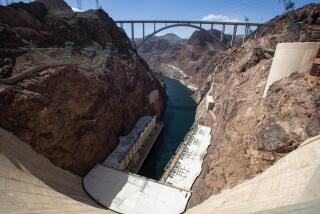Bay Area Raises Rates, Imposes Water Rationing
- Share via
SAN FRANCISCO — An estimated 2 million people--a third of the population of the greater Bay Area--began paying more to use less water Wednesday under emergency water-rationing rules adopted by the San Francisco Public Utilities Commission.
City residents and suburbanites who draw water from San Francisco’s Hetch-Hetchy aqueduct system will pay 14% to 27.6% more while being required to use 25% less water than they did at the beginning of the current drought in 1987, city officials said.
San Francisco joins at least five other California water agencies that have started drought-driven rationing programs. San Jose, California’s third-largest city, ordered customers to cut consumption by 20%, and similar cuts have become law in Ventura, Santa Barbara, San Luis Obispo and Monterey.
Rationing proposals are pending in Los Angeles, Simi Valley, Ojai, and San Clemente. El Dorado County northeast of Sacramento saves water by banning new construction but has not yet limited consumption by residents.
Utilities commission president Rodel Rodis called the city’s water shortage “a real emergency.” Streams that usually pour 700,000 acre-feet of water annually into city reservoirs gave only 580,000 acre-feet in the last four years combined.
Voluntary conservation already has cut consumption 12%, Rodis said, but to help save an additional 13% the city has banned the hosing down of sidewalks, the use of decorative fountains and routine serving of water in restaurants.
Customers who fail to adequately cut their consumption will be fined. Penalties would come in bill surcharges ranging from 10% to 1,000%, depending on the amount of excess.
San Francisco, which developed a normally abundant water supply by damming Yosemite’s Hetch-Hetchy Valley in 1914, has rationed water only twice before, in 1977, at the peak of the last great drought, and for a year starting in 1988.
The city has coupled its current rationing plan to a 14% rate increase for retail customers within the city and a 27.6% boost for the 30 wholesalers who resell water in suburban San Mateo, Santa Clara and Alameda counties.
Sheryl Davis, the water department’s customer services manager, said the rate hikes were imposed in part to compensate for lower consumption caused by the rationing program and to make up for lost hydroelectric sales.
Almost immediately, the new rationing plan produced a wave of concern and confusion among city water users. Davis said her department logged more than 200 calls before noon on Wednesday, most from people asking how they can appeal allotments to get more water.
Davis said the rationing plan, which sets monthly allotments to individual customers, requires larger cuts by people most able to conserve--those with lawns and landscaping instead of apartment dwellers.
“Customers with a flat level of water use year-round would be required to cut back less than those customers with a wide seasonal variation, because we believe there is more room for conservation there,” she said.
Generally, she said, the city assumes people can save 10% on indoor uses--drinking, cooking, washing--and 60% on landscaping and other outdoor uses.
For the most part, nursery owners and other water-dependent business operators have learned from earlier rationing programs and developed ways to cope with short supplies. Lee Leibrock of Potrero Gardens, for example, said he mixes polymers into his soil to hold water next to root systems, which then absorb it slowly and efficiently.
Davis said the city will not force businesses to meet the 25% reduction if such cuts threaten to shut them down. But before an exemption is granted, she said, the city will conduct a water audit to determine if the business has made a reasonable effort to reduce water consumption.
“We’re not trying to put people out of business,” she said. “But at the same time, we want to make sure they’re really conserving.”
Ironically, one industry is not worried by water rationing in San Francisco: industrial laundries. Companies that wash the city’s hotel sheets, industrial rags and laborers’ coveralls generally avoid San Francisco’s water-supply and sewage-disposal regulations by washing those items elsewhere.
“To tell you the truth, everybody does it now,” said Michael De Diego of Valley Industrial Services, which last year bought and closed San Francisco’s last industrial laundry. “Believe it or not, it’s more cost-effective to send our stuff to Sacramento and have it all processed there.”
The capital city, at the confluence of the Sacramento and American rivers, does not require meters to track a water supply that is ample despite the drought. Users are charged a flat monthly fee regardless of how much water they use.
More to Read
Sign up for Essential California
The most important California stories and recommendations in your inbox every morning.
You may occasionally receive promotional content from the Los Angeles Times.













